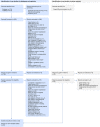Mortality of COVID-19 in patients with hematological malignancies versus solid tumors: a systematic literature review and meta-analysis
- PMID: 36795239
- PMCID: PMC9933827
- DOI: 10.1007/s10238-023-01004-5
Mortality of COVID-19 in patients with hematological malignancies versus solid tumors: a systematic literature review and meta-analysis
Abstract
Cancer patients are more vulnerable to COVID-19 compared to the general population, but it remains unclear which types of cancer have the highest risk of COVID-19-related mortality. This study examines mortality rates for those with hematological malignancies (Hem) versus solid tumors (Tumor). PubMed and Embase were systematically searched for relevant articles using Nested Knowledge software (Nested Knowledge, St Paul, MN). Articles were eligible for inclusion if they reported mortality for Hem or Tumor patients with COVID-19. Articles were excluded if they were not published in English, non-clinical studies, had insufficient population/outcomes reporting, or were irrelevant. Baseline characteristics collected included age, sex, and comorbidities. Primary outcomes were all-cause and COVID-19-related in-hospital mortality. Secondary outcomes included rates of invasive mechanical ventilation (IMV) and intensive care unit (ICU) admission. Effect sizes from each study were computed as logarithmically transformed odds ratios (ORs) with random-effects, Mantel-Haenszel weighting. The between-study variance component of random-effects models was computed using restricted effects maximum likelihood estimation, and 95% confidence intervals (CIs) around pooled effect sizes were calculated using Hartung-Knapp adjustments. In total, 12,057 patients were included in the analysis, with 2,714 (22.5%) patients in the Hem group and 9,343 (77.5%) patients in the Tumor group. The overall unadjusted odds of all-cause mortality were 1.64 times higher in the Hem group compared to the Tumor group (95% CI: 1.30-2.09). This finding was consistent with multivariable models presented in moderate- and high-quality cohort studies, suggestive of a causal effect of cancer type on in-hospital mortality. Additionally, the Hem group had increased odds of COVID-19-related mortality compared to the Tumor group (OR = 1.86 [95% CI: 1.38-2.49]). There was no significant difference in odds of IMV or ICU admission between cancer groups (OR = 1.13 [95% CI: 0.64-2.00] and OR = 1.59 [95% CI: 0.95-2.66], respectively). Cancer is a serious comorbidity associated with severe outcomes in COVID-19 patients, with especially alarming mortality rates in patients with hematological malignancies, which are typically higher compared to patients with solid tumors. A meta-analysis of individual patient data is needed to better assess the impact of specific cancer types on patient outcomes and to identify optimal treatment strategies.
Keywords: COVID-19; Cancer; Leukemia; Lymphoma; Mortality; Tumor.
© 2023. The Author(s), under exclusive licence to Springer Nature Switzerland AG.
Conflict of interest statement
JMP is employed by and holds equity in Superior Medical Experts and Nested Knowledge. AM is employed by Superior Medical Experts. NH is employed by and holds equity in Nested Knowledge. KK has ownership interest in Nested Knowledge, Inc. JT, RT, and PO are employed by Nested Knowledge.
Figures





Similar articles
-
Intravenous magnesium sulphate and sotalol for prevention of atrial fibrillation after coronary artery bypass surgery: a systematic review and economic evaluation.Health Technol Assess. 2008 Jun;12(28):iii-iv, ix-95. doi: 10.3310/hta12280. Health Technol Assess. 2008. PMID: 18547499
-
Signs and symptoms to determine if a patient presenting in primary care or hospital outpatient settings has COVID-19.Cochrane Database Syst Rev. 2022 May 20;5(5):CD013665. doi: 10.1002/14651858.CD013665.pub3. Cochrane Database Syst Rev. 2022. PMID: 35593186 Free PMC article.
-
Drugs for preventing postoperative nausea and vomiting in adults after general anaesthesia: a network meta-analysis.Cochrane Database Syst Rev. 2020 Oct 19;10(10):CD012859. doi: 10.1002/14651858.CD012859.pub2. Cochrane Database Syst Rev. 2020. PMID: 33075160 Free PMC article.
-
Risk of thromboembolism in patients with COVID-19 who are using hormonal contraception.Cochrane Database Syst Rev. 2023 Jan 9;1(1):CD014908. doi: 10.1002/14651858.CD014908.pub2. Cochrane Database Syst Rev. 2023. Update in: Cochrane Database Syst Rev. 2023 May 15;5:CD014908. doi: 10.1002/14651858.CD014908.pub3. PMID: 36622724 Free PMC article. Updated.
-
Electronic cigarettes for smoking cessation.Cochrane Database Syst Rev. 2022 Nov 17;11(11):CD010216. doi: 10.1002/14651858.CD010216.pub7. Cochrane Database Syst Rev. 2022. Update in: Cochrane Database Syst Rev. 2024 Jan 8;1:CD010216. doi: 10.1002/14651858.CD010216.pub8. PMID: 36384212 Free PMC article. Updated.
Cited by
-
COVID-19 in immunocompromised patients after hematopoietic stem cell transplantation: a pilot study.Blood Sci. 2024 Jan 25;6(2):e00183. doi: 10.1097/BS9.0000000000000183. eCollection 2024 Apr. Blood Sci. 2024. PMID: 38283406 Free PMC article.
-
Factors Associated With Mortality in Leukemia and Lymphoma With COVID-19: A National Inpatient Sample Analysis (2020-2021).Cureus. 2025 Jun 22;17(6):e86534. doi: 10.7759/cureus.86534. eCollection 2025 Jun. Cureus. 2025. PMID: 40698223 Free PMC article.
-
COVID-19 and Cancer Care: A Review and Practical Guide to Caring for Cancer Patients in the Era of COVID-19.Curr Oncol. 2024 Sep 10;31(9):5330-5343. doi: 10.3390/curroncol31090393. Curr Oncol. 2024. PMID: 39330021 Free PMC article. Review.
-
Castleman disease patients report mild COVID-19 symptoms and mount a humoral response to SARS-CoV-2 vaccination.Blood Neoplasia. 2024 Mar;1(1):100002. doi: 10.1016/j.bneo.2024.100002. Epub 2024 Feb 15. Blood Neoplasia. 2024. PMID: 39044861 Free PMC article.
-
Epcoritamab in relapsed/refractory large B-cell lymphoma: 2-year follow-up from the pivotal EPCORE NHL-1 trial.Leukemia. 2024 Dec;38(12):2653-2662. doi: 10.1038/s41375-024-02410-8. Epub 2024 Sep 25. Leukemia. 2024. PMID: 39322711 Free PMC article.
References
-
- COVID-19 dashboard by the center for systems science and engineering (CSSE) at Johns Hopkins University. In. Coronavirus resource center: Johns Hopkins University & Medicine. 2020
-
- Izcovich A, Ragusa MA, Tortosa F, Lavena Marzio MA, Agnoletti C, Bengolea A, Ceirano A, Espinosa F, Saavedra E, Sanguine V, Tassara A, Cid C, Catalano HN, Agarwal A, Foroutan F, Rada G. Prognostic factors for severity and mortality in patients infected with COVID-19: a systematic review. PLoS ONE. 2020;15(11):e0241955. doi: 10.1371/journal.pone.0241955. - DOI - PMC - PubMed
-
- Parohan M, Yaghoubi S, Seraji A, Javanbakht MH, Sarraf P, Djalali M. Risk factors for mortality in patients with Coronavirus disease 2019 (COVID-19) infection: a systematic review and meta-analysis of observational studies. Aging Male. 2020;23(5):1416. doi: 10.1080/13685538.2020.1774748. - DOI - PubMed
Publication types
MeSH terms
LinkOut - more resources
Full Text Sources
Medical

